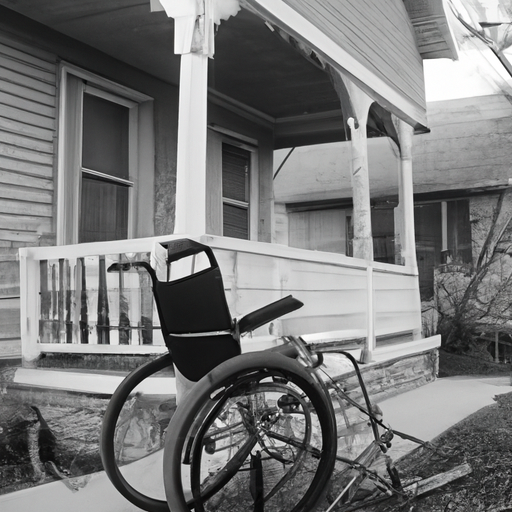Black Americans face disproportionately high rates of disability as they age, which can hinder their ability to remain in their own homes. A recent survey found that Black adults are more likely than white adults to develop disabilities that prevent them from aging in place. The survey, which collected data from nearly 2,300 Americans aged 50 to 80, revealed that over 40% of disabled respondents were Black. This poses a significant obstacle to the goal of aging in place, as it increases the need for already limited resources. Additionally, over half of Black adults surveyed fell into a low-income category. These findings shed light on the challenges and disparities faced by older Black Americans in maintaining their independence as they age.
Disproportionate Disability Rates for Older Black Americans
Prevalence of Disability among Older Adults
According to a recent survey conducted between January and February of 2022, almost one-third of participants aged 50 to 80 reported having a disability. This finding highlights the prevalence of disability among older adults in the United States. The survey gathered information on age, gender, sexual orientation, income, disability status, race, ethnicity, and overall quality of life indicators such as health status and social support.
Higher Disability Rates among Black Americans
One of the significant findings of the survey was that over 40% of disabled respondents were Black. This suggests that Black Americans have higher disability rates compared to other racial groups. This disparity in disability rates is a cause for concern, as it affects the ability of older Black Americans to age in place and stay within their communities.

Impact on Aging in Place
Aging in place refers to the desire of older adults to spend their final days in the peace and comfort of their own homes. However, the higher disability rates among Black Americans pose obstacles to aging in place for disabled individuals. The increased risk for disability results in a higher need for resources that are already limited. This means that older Black Americans may face challenges in accessing the support and assistance they need to remain in their homes.
Income Disparities and Limited Resources
The survey also revealed significant income disparities among older adults. Over half of Black adults surveyed had annual incomes under $30,000, indicating low-income households. This limited financial resources further amplify the difficulties faced by disabled older Black Americans in aging in place. Without sufficient income to support their needs, they may struggle to access necessary resources, modifications, and support services to accommodate their disabilities.

Factors Affecting Quality of Life
Several factors were identified in the survey that can affect the quality of life of disabled older adults, particularly Black Americans. Living with a disability can impact an individual’s confidence in their ability to get help when needed. Similarly, living alone can also affect the level of confidence in getting help. The survey found that both disabled individuals and those living alone, particularly Black respondents, reported lower confidence levels in accessing the necessary support for aging in place. Additionally, Black respondents were more likely to report fair or poor health compared to other respondents.
Racial Disparities in Health
To understand the higher disability rates among older Black Americans, it is essential to consider the impact of racism on health outcomes. The long history of racism in the United States has contributed to a phenomenon known as weathering. Weathering refers to the cumulative toll that social, economic, and environmental stresses associated with racism take on an individual’s health. This phenomenon can explain why older Black adults face a notably higher disability risk and why they desire to avoid nursing home stays.

Historical Context of Racism and Weathering
The history of racism in the United States has left a lasting impact on the health of Black individuals. The constant stress and adversity faced by Black Americans have led to weathering, which affects their overall health and well-being. This weathering can contribute to the higher disability rates observed among older Black Americans. It is important to acknowledge the historical context of racism and the ongoing impacts it has on health disparities.
Barriers to Aging in Place for Disabled Elderly
Disabled elderly individuals face several barriers when it comes to aging in place. These barriers include the need for prioritized funding for accessible spaces, such as modifications to homes and public areas. Meeting the needs of disabled elderly individuals is crucial in enabling them to remain in their communities and maintain their independence. It is essential to address these barriers and ensure that disabled older adults have access to the support and resources they require.
Addressing the Issue: Meeting Accessibility Needs
To address the issue of disproportionate disability rates among older Black Americans, it is crucial to prioritize meeting accessibility needs. This includes allocating funding for modifications that make public and private spaces more accessible for disabled individuals. By ensuring that individuals can navigate their homes and communities with ease, we can help promote aging in place and improve the quality of life for disabled older adults.
Addressing the Issue: Eradicating Racism and Implementing Public Health Measures
Beyond meeting accessibility needs, eradicating racism and implementing public health measures are vital in addressing the disproportionate disability rates among older Black Americans. Structural racism limits access to healthcare, education, and other resources that directly impact health outcomes. By eradicating racism, we can reduce the barriers faced by older Black Americans in accessing healthcare and health education. Additionally, public health measures should aim to address racial disparities by targeting housing assistance, preventive healthcare, and other areas that can have a significant impact on the health and well-being of older Black Americans.
In conclusion, the survey findings highlight the disproportionate disability rates among older Black Americans. These disparities in disability rates impact the ability of older adults to age in place and stay within their communities. Limited resources, income disparities, and the impact of racism contribute to the challenges faced by disabled older Black Americans. Addressing these issues requires meeting accessibility needs, eradicating racism, and implementing public health measures that target racial disparities in health. By prioritizing the support and resources needed by disabled older adults, we can enhance their quality of life and promote aging in place for all individuals, regardless of their race or ethnicity.


